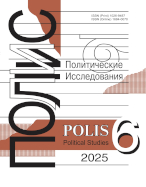Evolution of US electoral coalitions:
the case of three presidential elections
Makarenko B.I.,
HSE University, Moscow, Russia, bmakarenko@yandex.ru
elibrary_id: 251052 | ORCID: 0000-0002-0136-8785 | RESEARCHER_ID: L-3134-2015
Article received: 2025.01.30 09:22. Accepted: 2025.04.28 09:22

DOI: 10.17976/jpps/2025.04.02
EDN: PFKXTZ
Makarenko B.I. Evolution of US electoral coalitions: the case of three presidential elections. – Polis. Political Studies. 2025. No. 4. https://doi.org/10.17976/jpps/2025.04.02. EDN: PFKXTZ (In Russ.)
The article analyzes the basis of electoral support of two principal candidates in the 2024 US presidential elections in comparison with two previous campaigns, in which the Republican Party was represented by Donald Trump. The analysis is based on data from exit polls conducted for CNN. The analysis starts with a discussion of the role of “negative voting” (i.e., when the main motive of voting is against the opponent of preferred candidate) in all three campaigns. It continues with research on the dynamics of voting patterns of basic social and demographic cohorts of voters. The analysis shows that Trump received a solid majority of votes amongst: men, voters aged 45-65, voters without a college degree. He won the 2024 elections by securing majorities in cohorts of voters with an annual income below USD 100 000, in rural areas; and due to a broadening support of African and Latino American voters. Conversely, the Democratic Party had advantages among women, younger age cohorts (though more narrow in 2024 than during earlier campaigns), voters with college degrees, urban dwellers and more affluent people. The advantage in votes by middle-class suburban dwellers in all three cases secured for the winner overall electoral victories. The electoral basis of major US political parties (often referred to as “coalitions”) are complex. The Democratic base includes, on one hand, those cohorts of “underprivileged” voters which historically supported the party as the protector of their interests. However, in 2024 the Democrats lost most of the support of one of these cohorts, i.e., the blue-collar workers. On the other hand, the Democratic base includes liberal and progressive-minded cohorts, most of which are have confidence in life career prospects. The Republican support base includes all the conventional conservative-leaning cohorts. Not all the people belonging to such cohorts are radical or populist, but most of them accept Trump’s leadership style. A new “acquisition” for the party is the majority they obtained among voters without college degrees (mostly blue-collar workers).
References
Maisel, L.S. (2007). American political parties and elections: a very short introduction. Oxford; New York: Oxford University Press.
Przeworski, A. (2019). Crises of democracy. Cambridge; New York: Cambridge University Press.
Ruffini, P. (2023). Party of the people: inside the multiracial populist coalition remaking the GOP. New York: Simon & Schuster.
Teixeira, R., & Levin, Y. (2024). Politics without winners: can either party build a majority coalition? The American Enterprise Institute. https://www.aei.org/wp-content/uploads/2024/10/Politics-Without-Winners-Can-Either-Party-Build-a-Majority-Coalition.pdf?x85095
Zito, S., & Todd, B. (2018). The great revolt: inside the populist coalition reshaping American politics. Corbridge: Forum Books.
Duverger, M. (2002). Les partis politiques. (Russ. ed.: Duverger, M. Politicheskie partii. Moscow: Akademicheskii Proekt).
See also:
Shakleina T.A.,
Donald Trump and “New Populism” in America. – Polis. Political Studies. 2021. No5
Makarenko B.I.,
Conservatives About Conservatives. – Polis. Political Studies. 2017. No1
Sokolshchik L.M.,
American Conservatism and the Callenge of Contemporary Populism: Theoretical and Ideological Aspects. – Polis. Political Studies. 2021. No1
Kazun A.D., Kazun A.P.,
Neither a Friend. Not a Foe: Donald Trump in the Russian Media. – Polis. Political Studies. 2019. No1
Simonia N.A.,
Results of Presidential Elections in the United States and New Prospects for Formation of Multipolar World Order. – Polis. Political Studies. 2017. No2




.jpg)






 print
print
.jpg)
.jpg)